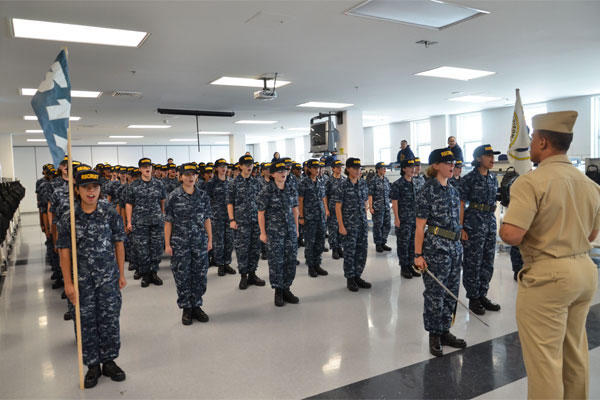WASHINGTON -- The Navy joins the nation in celebrating Women's History Month during the month of March, as announced in Naval Administrative message 039/13, released Feb. 22.
Commands are strongly encouraged to increase their knowledge and awareness of the contributions of women to our Navy and nation by celebrating the national Women's History Month theme, "Women Inspiring Innovation through Imagination: Celebrating Women in Science, Technology, Engineering and Mathematics (STEM)" through programs, exhibits, publications, and participation in military and community events.
One Navy STEM pioneer includes Grace Murray Hopper, who wanted to put her Ph.D. in Mathematics to use for her nation in the midst of World War II. In 1943, she joined the Naval Reserves and was commissioned as a lieutenant in 1944. During World War II she worked at the Bureau of Ordnance Computation Project at Harvard University and at the end of the war joined the Harvard faculty. Retiring as a rear admiral, Hopper, was recognized as a pioneer computer programmer, the co-inventor of Common Business Oriented Language (COBOL), and for coining the term "bug" for computer malfunctions. Hopper was buried at Arlington National Cemetery in 1992. USS Hopper (DDG 70) was commissioned as her namesake in 1997; this was only the second Navy warship to be named after a woman.
Also during World War II, the Navy launched the Women Accepted for Volunteer Emergency Service (WAVES) program. Along with Hopper, more than 85,000 WAVES worked in STEM fields as air traffic controllers, cryptologists, draftsmen, meteorologists, and translators during World War II.
In December 2012, history was made in the Navy's nuclear community when Lieutenant Junior Grade Marquette Leveque, assigned to the gold crew of USS Wyoming (SSBN 742), and Lieutenants Junior Grade Amber Cowan and Jennifer Noonan of USS Maine (SSBN 741) blue crew became the first female unrestricted line officers to qualify in submarines and receive their Submarine Warfare Insignia, also known as "dolphins."
Today in the Navy, female officers fill 10 percent of STEM positions, including engineering duty officers and information warfare professionals. Female enlisted Sailors make up 22 percent of the cryptology and intelligence community and 21 percent of operational ratings, including aviation warfare systems operators and sonar technicians. Female Sailors continue to excel both ashore and afloat, serving in various STEM related fields. More than 54,000 active duty women and more than 10,000 female Reservists are serving in the Navy. They make up 17.3 percent of the force and make indispensable contributions to our mission and operations. Nearly 59,000 women serve in a wide range of specialties as Navy civilians. The current Navy Total Force includes 33 active and Reserve female flag officers, 67 female senior executive service members, 56 female command master chiefs, and 6 female command senior chiefs leading from the front.
Currently, the top three highest-ranking female officers in the Navy are Vice Adm. Carol Pottenger, Vice Adm. Michelle Howard, and Vice Adm. Robin Braun. Pottenger, a surface warfare officer, was one of the first women selected for sea duty and went on to become the third commander, Navy Expeditionary Combat Command. Howard, also a surface warfare officer, was the first African American woman to command a ship in the U.S. Navy when she took command of USS Rushmore (LSD 47), and in 2012 she became the first African-American woman to receive a third star in flag rank within the Department of Defense when she was promoted Aug. 24. Braun, a career naval aviator and former commanding officer of VR-48, has more than 5,800 flight hours in Navy aircraft.
The top three highest-ranking female enlisted leaders in the Navy are Fleet Master Chief Joann Ortloff, Fleet Master Chief April Beldo, and Force Master Chief Nancy Hollingsworth. Force Master Chief April Beldo, currently the Naval Education and Training Command Force Master Chief, will make history as the Navy's first female African American Fleet Master Chief when she assumes her position as the Manpower, Personnel, Training and Education (MPT&E) fleet master chief later this month.
The Navy's 67-strong Senior Executive Service also has a strong STEM presence amongst its seniormost women. Carla Lucchino, Department of Navy Assistant for Administration is the top female civilian SES. Steffanie Easter, executive director for the F-35 Lightning II Joint Program Office, holds a bachelor's degree in chemical engineering and master's degree in engineering management. Easter is currently leading the F-35 Lightning II Joint Program, the Department of Defense's initiative for defining affordable and sustainable fifth-generation strike aircraft.


























